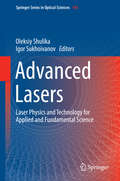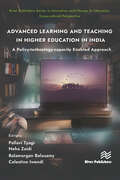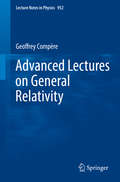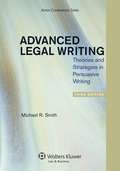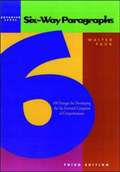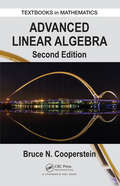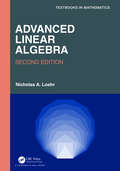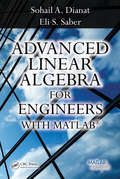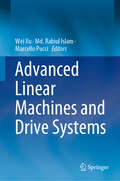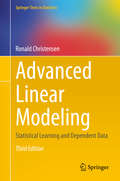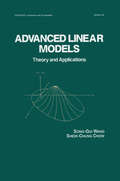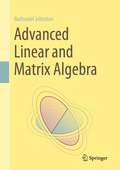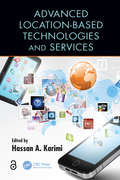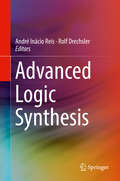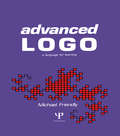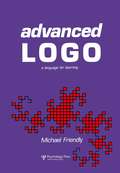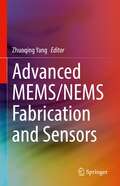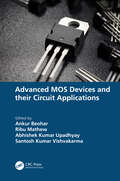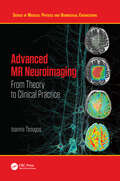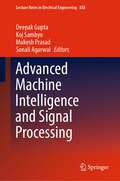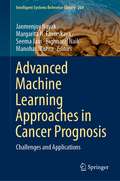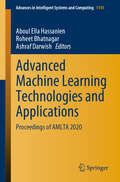- Table View
- List View
Advanced Lasers: Laser Physics and Technology for Applied and Fundamental Science (Springer Series in Optical Sciences #193)
by Oleksiy Shulika Igor SukhoivanovPresenting a blend of applied and fundamental research in highly interdisciplinary subjects of rapidly developing areas, this book contains contributions on the frontiers and hot topics of laser physics, laser technology and laser engineering, and covers a wide range of laser topics, from all-optical signal processing and chaotic optical communication to production of superwicking surfaces, correction of extremely high-power beams, and generation of ultrabroadband spectra. It presents both review-type contributions and well researched and documented case studies, and is intended for graduate students, young scientist, and emeritus scientist working/studying in laser physics, optoelectronics, optics, photonics, and adjacent areas. The book contains both experimental and theoretical studies, as well as combinations of these two, which is known to be a most useful and interesting form of reporting scientific results, allowing students to really learn from each contribution. The book contains over 130 illustrations.
Advanced Leadership Field Perspectives: Detroit
by Rosabeth Moss Kanter Ai-Ling Jamila MaloneIndustry and Background Note
Advanced Leadership Field Perspectives: Shanghai
by William C. Kirby Erica M ZendellIndustry and Background Note
Advanced Learning and Teaching in Higher Education in India: A Policy-technology-capacity Enabled Approach
by Pallavi Tyagi Celestine Iwendi Neha Zaidi Balamurgan BalusamyThis book comprehensively covers the evolution of advanced learning pedagogy and innovative technologies like open educational resources and blended learning models. It specifically talks about the future of technology-enhanced learning and how advanced technology and government policies together are trying to impact learning outcomes globally. Nowadays in a flexible learning environment, technology plays a significant role in higher education systems. Both educators and students are playing prominent roles in its successful implementation. Advanced learning pedagogy by using technology has not only changed teaching procedures but has also evolved the relationship among multiple stakeholders.The content of the book is neatly segregated into four parts. Part I covers the concept and evolution of digital learning and education technology. This part examines the role of technology in higher education and proposes a toolkit for personalized learning and continuous assessment.Parts II and III creatively represent the innovative teaching techniques and learning models under advance learning pedagogy. Chapters under parts II and III are specially designed to present the more simplistic view of various technology-based advanced learning models and resources like flipped classes, gaming designs for e-learning, etc. Part III of the book also extensively covers various case studies/instructor’s stories of technology enabled learning experiences.Part IV focuses on the evaluation of advance learning pedagogy and tools. It also covers the future of information in learning (like formative analytics) and improved learning outcomes using technology and government initiatives in the form of various future oriented education policies like the Digital Action Education Plan (2021–2027).The wide-ranging content also covers the challenges of implementation of advanced learning pedagogy and offers recommendations to overcome such challenges. The book will grab the attention of the modern (IT-enabled) instructor’s fraternity, and students and researchers in the area of technology and education. The book can be further used by policymakers and educational-technology startups to formulate and design technology-based higher education teaching policies and procedures which are indeed helpful in measuring learning outcomes.
Advanced Lectures on General Relativity
by Geoffrey CompèreThese lecture notes are intended for starting PhD students in theoretical physics who have a working knowledge of General Relativity. The four topics covered are: Surface charges as conserved quantities in theories of gravity; Classical and holographic features of three-dimensional Einstein gravity; Asymptotically flat spacetimes in four dimensions: BMS group and memory effects; The Kerr black hole: properties at extremality and quasi-normal mode ringing. Each topic starts with historical foundations and points to a few modern research directions.
Advanced Legal Writing: Theories and Strategies in Persuasive Writing (Third Edition)
by Michael R. SmithWith a practical focus on persuasive writing strategy, Michael R. Smith identifies and explores three processes of persuasive writing--logos, pathos, and ethos--and provides a thorough introduction to the elements of rhetorical style. Using detailed how-to guides and plenty of examples, the author's distinctive approach to persuasive writing examines: technical aspects of rhetorical style: metaphor, literary allusion, figures of speech, and graphic design three basic processes of persuasive legal writing strategy: Logos: logic and rational argument Pathos: value-based argument Ethos: establishing credibility interdisciplinary contributions to persuasive writing from fields such as cognitive psychology, classical rhetoric, and morality theory effective strategies that extend beyond the trial or appellate brief to a broad range of documents and settings In the Second Edition, the reader will find: a new organization that puts a greater emphasis on practice and relatively less on theory for each of the three processes of persuasive writing strategy a new six-Part organization: I. Introduction II. Logos Strategies III. Pathos Strategies IV. Ethos Strategies V. Rhetorical Style VI. The Ethics and Morality of Persuasion coverage of new developments in cognitive psychology, Pathos persuasion, and the role of metaphor in persuasive legal writing. the same manageable length For a complete examination of the technique and strategy behind persuasive writing, Smith's text strikes the right balance of depth and scope for upper-level legal writing courses.
Advanced Level: Six-Way Paragraphs
by Walter PaukSix-Way Paragraphs, a three-level series, teaches the basic skills necessary for reading factual material through the use of the following six types of questions: subject matter, main idea, supporting details, conclusions, clarifying devices, and vocabulary in context.
Advanced Linear Algebra (Textbooks in Mathematics)
by Bruce CoopersteinThis book discusses structure theory of an operator, topics on inner product spaces, and trace and determinant functions of a linear operator. It addresses bilinear forms with a full treatment of symplectic spaces and orthogonal spaces, as well as explains construction of tensor, symmetric, and exterior algebras. Featuring several new exercises, the second edition adds coverage of sesquilinear forms, linear groups, matrices, normed vector spaces, orthogonal spaces over perfect fields of characteristic two, and Clifford algebras. A solutions manual is available upon qualifying course adoption.
Advanced Linear Algebra (Textbooks in Mathematics)
by Nicholas A. LoehrDesigned for advanced undergraduate and beginning graduate students in linear or abstract algebra, Advanced Linear Algebra covers theoretical aspects of the subject, along with examples, computations, and proofs. It explores a variety of advanced topics in linear algebra that highlight the rich interconnections of the subject to geometry, algebra, analysis, combinatorics, numerical computation, and many other areas of mathematics.The author begins with chapters introducing basic notation for vector spaces, permutations, polynomials, and other algebraic structures. The following chapters are designed to be mostly independent of each other so that readers with different interests can jump directly to the topic they want. This is an unusual organization compared to many abstract algebra textbooks, which require readers to follow the order of chapters.Each chapter consists of a mathematical vignette devoted to the development of one specific topic. Some chapters look at introductory material from a sophisticated or abstract viewpoint, while others provide elementary expositions of more theoretical concepts. Several chapters offer unusual perspectives or novel treatments of standard results.A wide array of topics is included, ranging from concrete matrix theory (basic matrix computations, determinants, normal matrices, canonical forms, matrix factorizations, and numerical algorithms) to more abstract linear algebra (modules, Hilbert spaces, dual vector spaces, bilinear forms, principal ideal domains, universal mapping properties, and multilinear algebra).The book provides a bridge from elementary computational linear algebra to more advanced, abstract aspects of linear algebra needed in many areas of pure and applied mathematics.
Advanced Linear Algebra for Engineers with MATLAB
by Sohail A. Dianat Eli SaberArming readers with both theoretical and practical knowledge, Advanced Linear Algebra for Engineers with MATLAB® provides real-life problems that readers can use to model and solve engineering and scientific problems in fields ranging from signal processing and communications to electromagnetics and social and health sciences. Facilitating a unique understanding of rapidly evolving linear algebra and matrix methods, this book: Outlines the basic concepts and definitions behind matrices, matrix algebra, elementary matrix operations, and matrix partitions, describing their potential use in signal and image processing applications Introduces concepts of determinants, inverses, and their use in solving linear equations that result from electrical and mechanical-type systems Presents special matrices, linear vector spaces, and fundamental principles of orthogonality, using an appropriate blend of abstract and concrete examples and then discussing associated applications to enhance readers’ visualization of presented concepts Discusses linear operators, eigenvalues, and eigenvectors, and explores their use in matrix diagonalization and singular value decomposition Extends presented concepts to define matrix polynomials and compute functions using several well-known methods, such as Sylvester’s expansion and Cayley-Hamilton Introduces state space analysis and modeling techniques for discrete and continuous linear systems, and explores applications in control and electromechanical systems, to provide a complete solution for the state space equation Shows readers how to solve engineering problems using least square, weighted least square, and total least square techniques Offers a rich selection of exercises and MATLAB® assignments that build a platform to enhance readers’ understanding of the material Striking the appropriate balance between theory and real-life applications, this book provides both advanced students and professionals in the field with a valuable reference that they will continually consult.
Advanced Linear Machines and Drive Systems
by Wei Xu Md. Rabiul Islam Marcello PucciThis book collects the latest theoretical and technological concepts in the design and control of various linear machines and drive systems. Discussing advances in the new linear machine topologies, integrated modeling, multi-objective optimization techniques, and high-performance control strategies, it focuses on emerging applications of linear machines in transportation and energy systems. The book presents both theoretical and practical/experimental results, providing a consistent compilation of fundamental theories, a compendium of current research and development activities as well as new directions to overcome critical limitations.
Advanced Linear Modeling: Statistical Learning and Dependent Data (Springer Texts in Statistics)
by Ronald ChristensenThis book introduces several topics related to linear model theory, including: multivariate linear models, discriminant analysis, principal components, factor analysis, time series in both the frequency and time domains, and spatial data analysis. This second edition adds new material on nonparametric regression, response surface maximization, and longitudinal models. The book provides a unified approach to these disparate subjects and serves as a self-contained companion volume to the author's Plane Answers to Complex Questions: The Theory of Linear Models. Ronald Christensen is Professor of Statistics at the University of New Mexico. He is well known for his work on the theory and application of linear models having linear structure.
Advanced Linear Models: Theory and Applications (Statistics: Textbooks and Monographs #141)
by Shein-Chung Chow Song-Gui WangThis work details the statistical inference of linear models including parameter estimation, hypothesis testing, confidence intervals, and prediction. The authors discuss the application of statistical theories and methodologies to various linear models such as the linear regression model, the analysis of variance model, the analysis of covariance model, and the variance components model.
Advanced Linear and Matrix Algebra
by Nathaniel JohnstonThis textbook emphasizes the interplay between algebra and geometry to motivate the study of advanced linear algebra techniques. Matrices and linear transformations are presented as two sides of the same coin, with their connection motivating inquiry throughout the book. Building on a first course in linear algebra, this book offers readers a deeper understanding of abstract structures, matrix decompositions, multilinearity, and tensors. Concepts draw on concrete examples throughout, offering accessible pathways to advanced techniques. Beginning with a study of vector spaces that includes coordinates, isomorphisms, orthogonality, and projections, the book goes on to focus on matrix decompositions. Numerous decompositions are explored, including the Shur, spectral, singular value, and Jordan decompositions. In each case, the author ties the new technique back to familiar ones, to create a coherent set of tools. Tensors and multilinearity complete the book, with a study of the Kronecker product, multilinear transformations, and tensor products. Throughout, “Extra Topic” sections augment the core content with a wide range of ideas and applications, from the QR and Cholesky decompositions, to matrix-valued linear maps and semidefinite programming. Exercises of all levels accompany each section. Advanced Linear and Matrix Algebra offers students of mathematics, data analysis, and beyond the essential tools and concepts needed for further study. The engaging color presentation and frequent marginal notes showcase the author’s visual approach. A first course in proof-based linear algebra is assumed. An ideal preparation can be found in the author’s companion volume, Introduction to Linear and Matrix Algebra.
Advanced Location-Based Technologies and Services
by Hassan A. KarimiSince the publication of the first edition in 2004, advances in mobile devices, positioning sensors, WiFi fingerprinting, and wireless communications, among others, have paved the way for developing new and advanced location-based services (LBSs). This second edition provides up-to-date information on LBSs, including WiFi fingerprinting, mobile computing, geospatial clouds, geospatial data mining, location privacy, and location-based social networking. It also includes new chapters on application areas such as LBSs for public health, indoor navigation, and advertising. In addition, the chapter on remote sensing has been revised to address advancements.
Advanced Logic Synthesis
by Rolf Drechsler André Inácio ReisThis book provides a single-source reference to the state-of-the-art in logic synthesis. Readers will benefit from the authors' expert perspectives on new technologies and logic synthesis, new data structures, big data and logic synthesis, and convergent logic synthesis. The authors describe techniques that will enable readers to take advantage of recent advances in big data techniques and frameworks in order to have better logic synthesis algorithms.
Advanced Logo: A Language for Learning (Computer Science for the Behavioral Sciences Series)
by Michael FriendlyAdvanced Logo shows how LOGO can be used as a vehicle to promote problem solving skills among secondary students, college students, and instructors. The book demonstrates the wide range of educational domains that can be explored through LOGO including generative grammars, physical laws of motion and mechanics, artificial intelligence, robotics, and calculus.
Advanced Logo: A Language for Learning (Computer Science for the Behavioral Sciences Series)
by Michael FriendlyAdvanced Logo shows how LOGO can be used as a vehicle to promote problem solving skills among secondary students, college students, and instructors. The book demonstrates the wide range of educational domains that can be explored through LOGO including generative grammars, physical laws of motion and mechanics, artificial intelligence, robotics, and calculus.
Advanced MEMS/NEMS Fabrication and Sensors
by Zhuoqing YangThis book begins by introducing new and unique fabrication, micromachining, and integration manufacturing methods for MEMS (Micro-Electro-Mechanical Systems) and NEMS (Nano-Electro-Mechanical Systems) devices, as well as novel nanomaterials for sensor fabrications. The second section focuses on novel sensors based on these emerging MEMS/NEMS fabrication methods, and their related applications in industrial, biomedical, and environmental monitoring fields, which makes up the sensing layer (or perception layer) in IoT architecture. This authoritative guide offers graduate students, postgraduates, researchers, and practicing engineers with state-of-the-art processes and cutting-edge technologies on MEMS /NEMS, micro- and nanomachining, and microsensors, addressing progress in the field and prospects for future development.Presents latest international research on MEMS/NEMS fabrication technologies and novel micro/nano sensors;Covers a broad spectrum of sensor applications;Written by leading experts in the field.
Advanced MOS Devices and their Circuit Applications
by Santosh Kumar Vishvakarma Abhishek Kumar Upadhyay Ribu Mathew Ankur BeoharThis text comprehensively discusses the advanced MOS devices and their circuit applications with reliability concerns. Further, an energy-efficient Tunnel FET-based circuit application will be investigated in terms of the output voltage, power efficiency, energy consumption, and performances using the device circuit co-design approach. The book: • Discusses advanced MOS devices and their circuit design for energy- efficient systems on chips (SoCs).• Covers MOS devices, materials, and related semiconductor transistor technologies for the next-generation ultra-low-power applications.• Examines the use of field-effect transistors for biosensing circuit applications and covers reliability design considerations and compact modeling of advanced low-power MOS transistors.• Includes research problem statements with specifications and commercially available industry data in the appendix.• Presents Verilog-A model-based simulations for circuit analysis. The volume provides detailed discussions of DC and analog/RF characteristics, effects of trap-assisted tunneling (TAT) for reliability analysis, spacer-underlap engineering methodology, doping profile analysis, and work-function techniques. It further covers novel MOS devices including FinFET, Graphene field-effect transistor, Tunnel FETS, and Flash memory devices. It will serve as an ideal design book for senior undergraduate students, graduate students, and academic researchers in the fields including electrical engineering, electronics and communication engineering, computer engineering, materials science, nanoscience, and nanotechnology.
Advanced MR Neuroimaging: From Theory to Clinical Practice (Series in Medical Physics and Biomedical Engineering)
by Ioannis TsougosOver the last decade, some of the greatest achievements in the field of neuroimaging have been related to remarkable advances in magnetic resonance techniques, including diffusion, perfusion, magnetic resonance spectroscopy, and functional MRI. Such techniques have provided valuable insights into tissue microstructure, microvasculature, metabolism and brain connectivity. Previously available mostly in research environments, these techniques are now becoming part of everyday clinical practice in a plethora of clinical MR systems. Nevertheless, despite growing interest and wider acceptance, there remains a lack of a comprehensive body of knowledge on the subject, exploring the intrinsic complexity and physical difficulty of the techniques. This book focuses on the basic principles and theories of diffusion, perfusion, magnetic resonance spectroscopy, and functional MRI. It also explores their clinical applications and places emphasis on the associated artifacts and pitfalls with a comprehensive and didactic approach. This book aims to bridge the gap between research applications and clinical practice. It will serve as an educational manual for neuroimaging researchers and radiologists, neurologists, neurosurgeons, and physicists with an interest in advanced MR techniques. It will also be a useful reference text for experienced clinical scientists who wish to optimize their multi-parametric imaging approach.
Advanced Machine Intelligence and Signal Processing (Lecture Notes in Electrical Engineering #858)
by Deepak Gupta Sonali Agarwal Mukesh Prasad Koj SambyoThis book covers the latest advancements in the areas of machine learning, computer vision, pattern recognition, computational learning theory, big data analytics, network intelligence, signal processing, and their applications in real world. The topics covered in machine learning involve feature extraction, variants of support vector machine (SVM), extreme learning machine (ELM), artificial neural network (ANN), and other areas in machine learning. The mathematical analysis of computer vision and pattern recognition involves the use of geometric techniques, scene understanding and modeling from video, 3D object recognition, localization and tracking, medical image analysis, and so on. Computational learning theory involves different kinds of learning like incremental, online, reinforcement, manifold, multitask, semi-supervised, etc. Further, it covers the real-time challenges involved while processing big data analytics and stream processing with the integration of smart data computing services and interconnectivity. Additionally, it covers the recent developments to network intelligence for analyzing the network information and thereby adapting the algorithms dynamically to improve the efficiency. In the last, it includes the progress in signal processing to process the normal and abnormal categories of real-world signals, for instance signals generated from IoT devices, smart systems, speech, videos, etc., and involves biomedical signal processing: electrocardiogram (ECG), electroencephalogram (EEG), magnetoencephalography (MEG), and electromyogram (EMG).
Advanced Machine Learning Approaches in Cancer Prognosis: Challenges and Applications (Intelligent Systems Reference Library #204)
by Seema Jain Margarita N. Favorskaya Janmenjoy Nayak Bighnaraj Naik Manohar MishraThis book introduces a variety of advanced machine learning approaches covering the areas of neural networks, fuzzy logic, and hybrid intelligent systems for the determination and diagnosis of cancer. Moreover, the tactical solutions of machine learning have proved its vast range of significance and, provided novel solutions in the medical field for the diagnosis of disease. This book also explores the distinct deep learning approaches that are capable of yielding more accurate outcomes for the diagnosis of cancer. In addition to providing an overview of the emerging machine and deep learning approaches, it also enlightens an insight on how to evaluate the efficiency and appropriateness of such techniques and analysis of cancer data used in the cancer diagnosis. Therefore, this book focuses on the recent advancements in the machine learning and deep learning approaches used in the diagnosis of different types of cancer along with their research challenges and future directions for the targeted audience including scientists, experts, Ph.D. students, postdocs, and anyone interested in the subjects discussed.
Advanced Machine Learning Technologies and Applications: Proceedings of AMLTA 2020 (Advances in Intelligent Systems and Computing #1141)
by Ashraf Darwish Aboul Ella Hassanien Roheet BhatnagarThis book presents the refereed proceedings of the 5th International Conference on Advanced Machine Learning Technologies and Applications (AMLTA 2020), held at Manipal University Jaipur, India, on February 13 – 15, 2019, and organized in collaboration with the Scientific Research Group in Egypt (SRGE). The papers cover current research in machine learning, big data, Internet of Things, biomedical engineering, fuzzy logic and security, as well as intelligence swarms and optimization.
